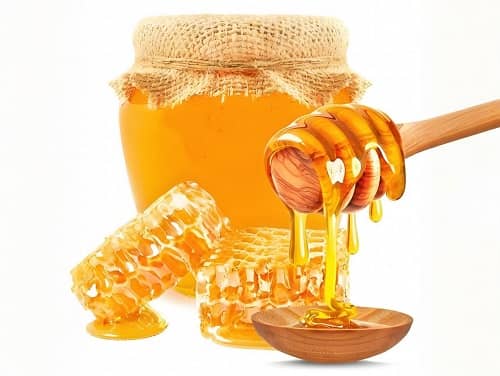Can you believe it? A tiny drop of honey packs such a powerful punch. Honey, commonly used in daily life as both food and medicine, is produced by worker bees from the nectar of flowers. It is a sweet, viscous liquid that ranges from pale yellow to brownish-yellow in color and can form a cloudy or crystallized appearance when cooled due to glucose precipitation.

In Traditional Chinese Medicine (TCM), honey is highly valued, and it is said to have five key medicinal functions.
Table of Contents
- Source and Composition of Honey
- Nature, Taste, and Meridians
- The Five Medicinal Functions of Honey
- Modern Research and Nutritional Benefits
- Cautions for Consuming Honey
1. Source and Composition of Honey
Honey is a sweet substance made by worker bees from flower nectar.
It is a pale yellow to brownish-yellow viscous liquid that may appear cloudy or crystallized at low temperatures due to the precipitation of glucose.
The main components of honey are glucose and fructose, which make up 70% of its content.
Honey also contains small amounts of sucrose, vitamins, minerals, amino acids, and enzymes.
2. Nature, Taste, and Meridians
📌 Taste: Sweet, Neutral
📌 Meridians: Lung, Spleen, Large Intestine
In TCM, honey is highly regarded. According to Compendium of Materia Medica, it has five key functions: clearing heat, tonifying the middle, detoxifying, moistening dryness, and alleviating pain.
3. The Five Medicinal Functions of Honey
📖 Compendium of Materia Medica states that honey has five key medicinal functions:
- Clears Heat: Raw honey is cool in nature and helps to clear heat and detoxify.
- Tonifies the Middle: Cooked honey is warm and helps to tonify the spleen and stomach.
- Detoxifies: Honey’s sweet and neutral nature allows it to detoxify and eliminate harmful substances.
- Moisturizes Dryness: Honey is gentle and moistening, helping to prevent dryness.
- Alleviates Pain: Honey has a soothing effect on pain, especially for abdominal, muscle, and skin-related pain.
Honey can harmonize and enhance the effects of other medicinal herbs, similar to licorice.
4. Modern Research and Nutritional Benefits
Modern research shows that honey is highly nutritious.
- The main components, glucose and fructose, are easily absorbed by the body without needing digestion.
- It contains various vitamins, minerals, amino acids, and enzymes, which help improve metabolism and boost immunity.
Honey also contains various enzymes, such as amylase, lipase, and sucrase, making it one of the most enzyme-rich natural foods.
5. Cautions for Consuming Honey
Although honey is rich in nutrition, there are some important guidelines to follow when consuming it:
⚠️ Excessive consumption may cause blood sugar levels to rise, especially for individuals with diabetes.
⚠️ Honey should not be given to infants under one year of age due to the potential risk of botulism.
⚠️ Avoid consuming honey at high temperatures, as this can destroy its beneficial enzymes. It’s best consumed with warm water.
✅ Conclusion
Honey is not just a sweet treat; it is a powerful natural remedy with five essential medicinal functions. From detoxification to pain relief, honey’s versatility makes it a treasured item in both culinary and medicinal practices. However, it’s important to consume honey thoughtfully and in moderation to enjoy its full health benefits.
如果下次你有新的文案,随时发给我,我继续为你整理双语版本!